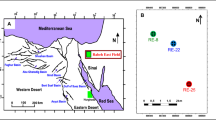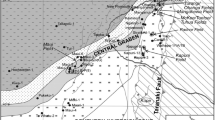Abstract
The present study deals with the petrophysical evaluation using well log data of Lower Goru Formation from five selected wells namely Nara-1, Kadanwari-3, Kadanwari-4, Gajwaro-1 and Mehrab-1 in the Lower Indus Basin. Various cross plots indicate that the formation of interest is mainly composed of sandstone, shale and carbonates. In addition, clay content is also analysed using potassium versus thorium and PEF versus Th/K ratio plots. Interactive Petrophysics (IP-2013) software is used to assess the petrophysical parameters. The volume of shale has been estimated between 6.1% and 14.07% from the studied wells. Similarly, the total porosity is observed between 14.6% and 18.02% while the effective porosity ranges 12.5–16.5%. The water saturation is quite low and exhibits between 14.05% and 31.58%. Moreover, the hydrocarbon saturation ranges 68.42–85.95% in the studied wells. 23 pay zones of variable thickness and significant hydrocarbons presence have been identified within the studied wells, thus proving the Lower Goru Formation as a promising reservoir. The study also indicates Nara-1 Well as the most prolific in terms of high hydrocarbon saturation and low water saturation. The study method can be used within the vicinity of Lower Indus Basin and similar basin elsewhere in the globe to quantify petrophysical properties of oil and gas wells and comprehend the reservoir potential.

Modified after Sultan (2015)












Similar content being viewed by others
References
Abbas ST, Mirza K, Arif SJ (2015) Lower Goru Formation-3D modeling and petrophysical interpretation of Sawan gas field, Lower Indus Basin, Pakistan. Nucleus 52(3):138–145
Abd El-Gawad EA (2007) The use of well logs to determine the reservoir characteristics of Miocene rocks at the Bahar North East field, Gulf of Sues. Egypt J Pet Geol 30(2):175–188
Al-Qayim B, Rashid F (2012) Reservoir characteristics of the Albian Upper Qamchuqa Formation Carbonates, Tqa oilfield, Kurdistan, Iraq. J Pet Geol 35(4):317–342
Asquith G, Krygowski D (2004) Basic well log analysis, 2nd edn. AAPG methods in exploration series vol 16, pp 244
Azeem T, Chun WY, Lisa M, Khalid P, Qing LX, Ehsan MI, Munawar MJ, Wei X (2017) An integrated petrophysical and rock physics analysis to improve reservoir characterization of Cretaceous sand intervals in Middle Indus Basin, Pakistan. J Geophys Eng 14:212–225
Bloch S, Lander RH, Bonnell LM (2002) Anomalously high porosity andpermeability in deeply buried sandstone reservoirs: origin and predictability. AAPG Bull 86:301–328
Burke JA, Campbell RL Jr, Schmidt AW (1969) The litho-porosity cross plot: a method of determining rock characteristics for computation of log data. Log Data Analyst 10:25–43
Clavier C, Coates G, Dumanoir J (1984) Theoretical and experimental bases for the dual water model for the interpretation of shaly sands. SPE J 24(2):153–168
Deer WA, Howie RA, Zusmann J (1998) An introduction the rock forming minerals. Longman, London, p 528
El-Din ES, Mesbah MA, Kassab MA, Mohammed IF, Cheadle BA (2013) Assessment of petrophysical parameters of clastics using well logs: the Upper Miocene in El-Wastani gas field, onshore nile Delta, Egypt. Pet Explot Dev 40(4):488–494
Hakimi MH, Al-Qadasi BA, Al-Sharrabi Y, Al-Sorore OT, Al-Samet NG (2017) Petrophysical properties of Cretaceous clastic rocks (Qishn Formation) in the Sharyoof oilfield, onshore Masila Basin, Yemen. Egypt J Pet 26(2):439–455
Hancock NJ, Taylor AM (1978) Clay mineral Diagenesis and oil migration in the Middle Jurassic Brent Group. J Geol Soc Lond 135:69–72
Heald MT, Larese RE (1974) Influence of coatings on quartz cementation. J Sediment Pet 44:1269–1274
Hussain M, Getz SL, Oliver R (1991) Hydrocarbon accumulation parameters in the central portion of the lower Indus basin of Pakistan. In: Ahmed G, Kamal A, Zaman ASH, Humayon M (eds) Proceedings of international petroleum seminar on New directions and strategies for accelerating petroleum exploration and production in Pakistan, Islamabad, Nov. 22–24, 13
Islam MA (2009) Diagenesis and reservoir quality of Bhuban sandstones (Neogene), Titas Gas Field, Bengal Basin, Bangladesh. J Asian Earth Sci 35(1):89–100
Jiang S (2012) Clay Minerals from the perspective of oil and gas exploration. In: Valašcova M, Martynkova GS (eds) Clay minerals in nature-their characterization, modification and application, pp 21–38. https://doi.org/10.5772/47790
Jiang S, Wang H, Cai D (2010) The secondary porosity and permeability characteristics of Tertiary strata and their origins, Liaodong Bay Basin, China. Energy Explor Exploit 28(4):207–222
Jumat N, Shalaby MR, Islam MA (2018) Integrated reservoir characterization of the Paleocene Farewell Formation, Taranaki Basin, New Zealand, using petrophysical and petrographical analyses. J Pet Explor Prod Technol 8:685–701
Kadri IB (1995) Petroleum Geology of Pakistan. Pakistan Petroleum Limited, pp:1-275
Khan N, Konate AA, Zhu P (2013) Integrated Geophysical Study of the Lower Indus Platform Basin area of Pakistan. International Journal of Geosciences 4:1242–1247
Levorsen LA (1972) Geology of petroleum 2nd ed. Freeman, W.H. and Company Pub, San Francisco:724
Munir K, Iqbal MA, Farid A, Shabih S (2011) Mapping the productive sands of Lower Goru Formation by using Seismic Stratigraphy and rock physical studies in Sawan area, southern Pakistan: a case study. J Petrol Explor Prod Technol 1:33–42
Naeem M, Jafri MK, Moustafa SSR, Al-Arifi NS, Asim S, Khan F, Ahmed N (2016) Seismic and well log driven structural and petrophysical analysis of the Lower Goru Formation in the Lower Indus Basin. Pakistan Geosci J 20(1):57–75
Naseer T, Asim S, Siddiqui MM, Naeem M, Solangi SH, Khan FB (2017) Seismic attributes application to evaluate the Goru clastics in the Indus Platform, Pakistan. Arab J Geosci 10(7):1–13
Nisar UB, Khan S, Khan MR, Shahzad A, Farooq M, Bukhari SAA (2016) Structural and reservoir interpretation of cretaceous lower Goru Formation, Sanghar area, Lower Indus Basin, Pakistan. Journal of Himalayan Earth Sciences 49(1):41–49
Odin GS, Matter A (1981) De glauconiarium originae. Sedimentology 28:614–641
Qadri SMT, Shalaby MR, Islam MA (2016) Source rock characterization and hydrocarbon generation modelling of the Middle to Late Eocene Mangahewa Formation in Taranaki Basin, New Zealand. Arab J Geosci 9:559
Qadri SMT, Islam MA, Shalaby MR, ul Haque AKME (2017) Seismic interpretation and structural modelling of Kupe field, Taranaki Basin, New Zealand. Arab J Geosci 10(14):295
Qadri SMT, Islam MA, Shalaby MR (2019) Three dimensional petrophysical modelling and volumetric analysis to model the reservoir potential of the Kupe Field, Taranaki Basin, New Zealand. Nat Resour Res 28:369
Quadri V, Shuaib SM (1986) Hydrocarbon Prospects of Southern Indus Basin, Pakistan. AAPG Bull 70(6):730–747
Rider MH (1996) The geological interpretation of Well Logs. John Wiley and Sons, New York
Sahito AG, Solangi SH, Usmani P, Brohi IA, Napar LD, Khokhar Q (2013) Sedimentologic studies of Upper sands of Lower Goru Formation based on well cuttings and wire line logs from wells of X Field in the subsurface of Sindh Monocline, Southern Indus Basin, Pakistan. Sindh Univ Res J 45(2):341–352
Siyar SM, Waqas M, Mehmood S, Jan A, Awais M, Islam F (2017) Petrophysical characteristics of lower goru formation (cretaceous) in Sawan gas filed, central indus basin, Pakistan. J Biol Environ Sci 10(5):260–266
Srodón J (1999) Use of clay minerals in constructing geological processes: recent advances and some perspectives. Clay Miner 34:27–37
Sultan M (2015) Seismic hazard analysis of Pakistan. J Geol Geosci 4(1):190
Taylor TR, Stancliffe R, Macaulay CI, Hathon LA (2004) High temperature quartz cementation and the timing of hydrocarbon accumulation in the Jurassic Norphlet Sandstone, offshore Gulf of Mexico, USA. In Cubit JM, England WA, Larter S (eds) Understanding petroleum reservoirs: Towards an integrated reservoir engineering and geochemical approach. Geol Soc Spec Pub vol 237, pp 257–278
Tiyan Y, Ayers WB (2010) Barnett shale (Mississippian), Fort Worth Basin, Texas: regional variations in gas and oil production and reservoir properties CSUG/SPE 137766, Canadian Unconventional Resources & International Petroleum Conference Calgary, Alberta, Canada, 19–21 October, https://doi.org/10.2118/137766-ms
Wandrey CJ, Law BE, Shah HA (2004) Sembar-Goru/Ghazij composite total petroleum system, Indus and Sulaiman-Kirthar geologic provinces, Pakistan and India. In: Wandrey CJ (ed) Petroleum systems and related geologic studies in region 8, South Asia. United States Geological Survey Bulletin 2208-C: 23
Warren EA, CurtiS CD (1989) The chemical composition of authigenic illite within two sandstone reservoirs as analysed by ATEM. Clay Miner 24:137–156
Worden RH, Burley SD (2003) Sandstone diagenesis: from sand to stone. In: Burley SD, Worden RH (eds) Clastic diagenesis: recent and ancient. International association of sedimentologists, vol 4. Blackwells, Oxford, pp 3–44
Worden RH, Morad S (2003) Clay minerals in sandstones: controls on formation, distribution and evolution. In: Worden RH, Morad S (eds) Clay mineral cements in sandstones. International Association of Sedimentologists Special Publications 34, Blackwell publishing, pp 3–41
Worthington PF (2003) Effect of clay content upon some physical properties of sandstone reservoirs. Int Assoc Sedimentol Spec Publ 34:191–211
Worthington PF (2010) Net pay-what is it? What does it do? How do we quantify? How do we use it? SPE Reserv Eval Eng 13(5):812–822
Wyllie MRJ (1963) The fundamentals of well log interpretations. Academic Press, New York
Zaigham NA, Mallick KA (2000) Prospect of hydrocarbon associated with fossil-rift structures of the southern Indus basin, Pakistan. AAPG Bull 84(11):1833–1848
Acknowledgements
Authors are grateful to Oil and Gas Cooperation Limited Pakistan (OGDCL) for providing the data sets. Authors are also thankful to Department of Physical and Geological Sciences, Universiti Brunei Darussalam for supporting with the technical and administrative facilities required to complete the research.
Author information
Authors and Affiliations
Corresponding author
Additional information
Publisher's Note
Springer Nature remains neutral with regard to jurisdictional claims in published maps and institutional affiliations.
Rights and permissions
About this article
Cite this article
Qadri, S.M.T., Islam, M.A. & Shalaby, M.R. Application of well log analysis to estimate the petrophysical parameters and evaluate the reservoir quality of the Lower Goru Formation, Lower Indus Basin, Pakistan. Geomech. Geophys. Geo-energ. Geo-resour. 5, 271–288 (2019). https://doi.org/10.1007/s40948-019-00112-5
Received:
Accepted:
Published:
Issue Date:
DOI: https://doi.org/10.1007/s40948-019-00112-5




